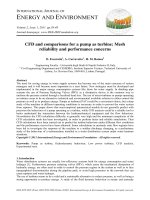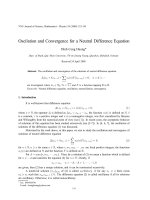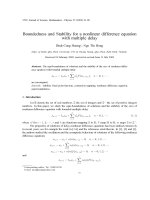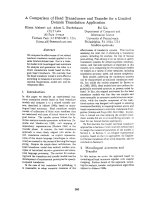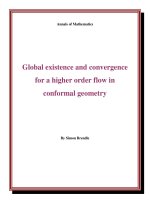Natural gas supply management and contract allocation and valuation for a power generation company
Bạn đang xem bản rút gọn của tài liệu. Xem và tải ngay bản đầy đủ của tài liệu tại đây (4.77 MB, 163 trang )
NATURAL GAS SUPPLY MANAGEMENT AND
CONTRACT ALLOCATION AND VALUATION
FOR A POWER GENERATION COMPANY
WENG RENRONG
NATIONAL UNIVERSITY OF SINGAPORE
2015
NATURAL GAS SUPPLY MANAGEMENT AND
CONTRACT ALLOCATION AND VALUATION
FOR A POWER GENERATION COMPANY
WENG RENRONG
(B.Eng., Shanghai Jiao Tong University)
A THESIS SUBMITTED
FOR THE DEGREE OF DOCTOR OF PHILOSOPHY
DEPARTMENT OF INDUSTRIAL AND SYSTEMS
ENGINEERING
NATIONAL UNIVERSITY OF SINGAPORE
2015Acknowledgements
First and foremost, I would like to express my deepest gratitude to my supervi-
sor Dr. Kim Sujin for her aspiring guidance, constructive criticism and invaluable
advice throughout my Ph.D career. Without her persistent help and encourage-
ment, there would be no way to accomplish this dissertation.
In addition, I am sincerely grateful to my committee members, Prof. Ng Kien
Ming and Dr. Tan Chin Hon for their illuminating views and brilliant comments
on this thesis. Furthermore, I would also like to express my great appreciation to
all my friends for their companion and continuous support.
Finally, a special thanks to my family. Their endless love and encouragement
drive me to face challenges and strive towards my goal.
iv
Contents
Declaration . . . . . . . . . . . . . . . . . . . . . . . . . . . . . . . . . iii
Acknowledgements . . . . . . . . . . . . . . . . . . . . . . . . . . . . . iv
Summary . . . . . . . . . . . . . . . . . . . . . . . . . . . . . . . . . . ix
List of Tables . . . . . . . . . . . . . . . . . . . . . . . . . . . . . . . . xi
List of Figures . . . . . . . . . . . . . . . . . . . . . . . . . . . . . . . . xii
1 Introduction 1
1.1 Background . . . . . . . . . . . . . . . . . . . . . . . . . . . . . . 1
1.1.1 Natural Gas Prices . . . . . . . . . . . . . . . . . . . . . . 2
1.1.2 Natural Gas Contracts . . . . . . . . . . . . . . . . . . . . 3
1.2 Motivation . . . . . . . . . . . . . . . . . . . . . . . . . . . . . . . 6
1.3
Natural Gas Supply Portfolio and Contract Allocation and Valua-
tion: A Brief Review . . . . . . . . . . . . . . . . . . . . . . . . . 7
1.3.1 Natural Gas Supply Portfolio . . . . . . . . . . . . . . . . 7
1.3.2 Single-Time Scale Contract Allocation and Valuation . . . 9
1.3.3 Multi-Time Scale Contract Allocation and Valuation . . . . 11
1.4 Research Gaps and Objectives . . . . . . . . . . . . . . . . . . . . 12
1.5 Outline of Thesis . . . . . . . . . . . . . . . . . . . . . . . . . . . 14
2 Literature Review 16
2.1 Stochastic Dynamic Programming . . . . . . . . . . . . . . . . . . 16
2.2 Methodology . . . . . . . . . . . . . . . . . . . . . . . . . . . . . 19
2.2.1 Backward Dynamic Programming . . . . . . . . . . . . . . 19
v
2.2.2 Approximate Dynamic Programming . . . . . . . . . . . . 21
2.2.3 Least-Squares Monte Carlo . . . . . . . . . . . . . . . . . 25
2.2.4 Algorithmic Strategy Comparison . . . . . . . . . . . . . . 27
2.3 Adaptive Policy . . . . . . . . . . . . . . . . . . . . . . . . . . . . 28
2.3.1 Base Stock Policy . . . . . . . . . . . . . . . . . . . . . . . 28
2.3.2 Bang-Bang Policy . . . . . . . . . . . . . . . . . . . . . . . 30
2.4 Multi-Time Scale Markov Decision Process . . . . . . . . . . . . . 31
2.4.1 Decision Dependent Uncertainty . . . . . . . . . . . . . . 33
3 Short-Term Natural Gas Supply Management 34
3.1 Introduction . . . . . . . . . . . . . . . . . . . . . . . . . . . . . . 34
3.2 Problem Description and Model Formulation . . . . . . . . . . . . 37
3.3 Optimal Base Stock Policy and Monotonicity . . . . . . . . . . . . 40
3.3.1 Price Monotonicity . . . . . . . . . . . . . . . . . . . . . . 44
3.4 Price Model . . . . . . . . . . . . . . . . . . . . . . . . . . . . . . 48
3.4.1 Mean Reverting Model . . . . . . . . . . . . . . . . . . . . 48
3.4.2 Trinomial Tree Construction . . . . . . . . . . . . . . . . . 49
3.4.3 Parameter Calibration and Monte Carlo Simulation . . . . 52
3.5 Numerical Study . . . . . . . . . . . . . . . . . . . . . . . . . . . 54
3.5.1 Experimental Settings . . . . . . . . . . . . . . . . . . . . 54
3.5.2 Value of Stochastic Solution . . . . . . . . . . . . . . . . . 54
3.6 Chapter Summary . . . . . . . . . . . . . . . . . . . . . . . . . . 57
4 Contract Negotiation and Price Determination 58
4.1 Introduction . . . . . . . . . . . . . . . . . . . . . . . . . . . . . . 58
4.2 Contract Valuation . . . . . . . . . . . . . . . . . . . . . . . . . . 60
4.2.1 Contract Valuation for the GENCO . . . . . . . . . . . . . 61
4.2.2 Contract Valuation for the Gas Supplier . . . . . . . . . . 62
4.3 Contract Price Determination . . . . . . . . . . . . . . . . . . . . 65
4.3.1 Relationship Between J
m
(Q) and J
s
(Q) . . . . . . . . . . . 65
vi
4.3.2 Nash Equilibrium . . . . . . . . . . . . . . . . . . . . . . . 68
4.4 Numerical Experiments . . . . . . . . . . . . . . . . . . . . . . . 70
4.4.1 Optimal Contract Price and Price Indexes . . . . . . . . . 71
4.4.2 Contract Price Determination . . . . . . . . . . . . . . . . 73
4.5 Chapter Summary . . . . . . . . . . . . . . . . . . . . . . . . . . 76
5 Multi-time Scale Markov Decision Process for Natural Gas Contract
Allocation and Valuation 77
5.1 Introduction . . . . . . . . . . . . . . . . . . . . . . . . . . . . . . 77
5.2 Problem Description and Model Formulation . . . . . . . . . . . . 81
5.2.1 Upper Time Level Markov Decision Process . . . . . . . . 82
5.2.2 Lower Time Level Markov Decision Process . . . . . . . . 85
5.3 Threshold Policy for Lower Time Level MDP . . . . . . . . . . . . 87
5.4 Least-Squares Policy Iteration Algorithm for Upper Time Level MDP 92
5.4.1 Policy Evaluation . . . . . . . . . . . . . . . . . . . . . . . 94
5.4.2 Policy Improvement . . . . . . . . . . . . . . . . . . . . . 96
5.4.3 Basis Function for Value Function Approximation . . . . . 99
5.4.4
Finite Difference Stochastic Approximation (FDSA) Algo-
rithm . . . . . . . . . . . . . . . . . . . . . . . . . . . . . 100
5.5 Convergence and Error Bound . . . . . . . . . . . . . . . . . . . . 102
5.6 Numerical Analysis . . . . . . . . . . . . . . . . . . . . . . . . . . 108
5.6.1 Experiment Setup . . . . . . . . . . . . . . . . . . . . . . 108
5.6.2 Value of Make Up Clause . . . . . . . . . . . . . . . . . . . 110
5.6.3 Performance of LSPI Algorithm . . . . . . . . . . . . . . . 117
5.7 Chapter Summary . . . . . . . . . . . . . . . . . . . . . . . . . . 123
6 Conclusions and Future Research 125
Bibliography 129
vii
A Proofs in Chapter 3 137
A.1 Proof of Lemma 3.5 . . . . . . . . . . . . . . . . . . . . . . . . . . 137
A.2 Proof of Lemma 3.6 . . . . . . . . . . . . . . . . . . . . . . . . . . 138
A.3 Proof of Lemma 3.7 . . . . . . . . . . . . . . . . . . . . . . . . . . 139
B Proofs in Chapter 5 143
B.1 Proof of Lemma 5.4 . . . . . . . . . . . . . . . . . . . . . . . . . . 143
B.2 Proof of Proposition 5.7 . . . . . . . . . . . . . . . . . . . . . . . 144
B.3 Proof of Proposition 5.8 . . . . . . . . . . . . . . . . . . . . . . . 146
viii
Summary
In Singapore, about 80 % of electricity is generated from natural gas. Natu-
ral gas supply for a power generation company (GENCO) is usually regulated
through the use of provision contracts in addition to market transactions. With
increasingly volatile gas prices in the deregulated environment, the profitability
of a GENCO heavily relies on its ability to manage the portfolio of natural gas
contract and spot trading. This thesis mainly concerns about the management of
natural gas supply and contract gas allocation and valuation taking into account
the volatile gas prices and various contractual flexibilities.
In this thesis, we first study the optimization problem of dynamically allocat-
ing contracted gas over a short-term horizon. It is shown that a price and stage
dependent base stock policy is optimal and the related optimal target levels mono-
tonically decrease with the spot price. With a trinomial price scenario tree, these
target levels can be easily computed to facilitate prompt contracted gas allocation.
Numerical analyses demonstrate the importance of taking price volatility into
consideration in the decision making process. Subsequently, we develop a novel
scheme to price a bilateral gas contract. By incorporating the contract valuations
for both the GENCO and the natural gas supplier, we unveil that there is always a
possibility for both contracting parties to negotiate and reach a unique mutually
acceptable equilibrium. The feasibility of the proposed pricing framework is vali-
dated by numerical results under various market conditions. Lastly, we consider a
medium-term contract allocation problem with hierarchically structured sequen-
tial decision making induced by emerging make up clause. A multi-time scale
Markov decision process (MMDP) model is proposed to address the interaction
of decision makings in two different time scales of short-term and medium-term.
We also contribute to developing a least-squares policy iteration (LSPI) algorithm
in conjunction with a finite difference stochastic approximation (FDSA) method
to solve the MMDP problem involving decision dependent uncertainty. Moreover,
ix
we rigorously establish the convergence guarantee and performance bound of
the proposed algorithm. Extensive numerical experiments show that our LSPI al-
gorithm outperforms the standard DP method, especially for a realistically sized
problem.
In summary, this thesis may provide valuable insights on dynamic energy
contract allocation and valuation in the presence of spot trading both in short-
term and medium-term.
x
List of Tables
2.1 Comparison between DP, ADP and LSM . . . . . . . . . . . . . . 28
3.1 Comparison between Secomandi (2010) and our work . . . . . . 36
3.2 Calibrated parameter values for the mean reversion model . . . . 52
3.3 Discretized demand distribution . . . . . . . . . . . . . . . . . . . 54
5.1 Estimated parameter values for monthly seasonality factors . . . 109
5.2 Discretized daily demand distribution in MMDP . . . . . . . . . . 110
5.3 Impact of seasonality on value of make up clause . . . . . . . . . 113
5.4 Impact of price volatility on value of make up clause . . . . . . . 115
5.5 Performance comparison between LSPI and DP . . . . . . . . . . 121
5.6 CPU time (hours) comparison between LSPI and DP . . . . . . . . 122
xi
List of Figures
1.1 Henry Hub spot price (1991-2010) . . . . . . . . . . . . . . . . . 3
1.2
Contract length for gas contracts 1980-2005 (Hedge and Fjeldstad,
2010) . . . . . . . . . . . . . . . . . . . . . . . . . . . . . . . . . 4
3.1 Planning horizon structure and sequence of events . . . . . . . . 38
3.2 Illustration of optimal base stock policy . . . . . . . . . . . . . . . 43
3.3 Illustration of price monotonicity of base stock target level . . . . 46
3.4 Price sample paths and trinomial tree . . . . . . . . . . . . . . . . 53
3.5 Effect of price volatility and withdraw capacity on V SS . . . . . . 55
3.6 Effect of price volatility and withdraw capacity on V
∗
and V E . . 56
4.1 Illustration of contract value and Pareto set I . . . . . . . . . . . 67
4.2 Contract valuation and price indexes . . . . . . . . . . . . . . . . 71
4.3
The contract value-quantity curves for different spot price variations
73
4.4
The optimal contract price and quantity for different spot price
variations . . . . . . . . . . . . . . . . . . . . . . . . . . . . . . . 75
5.1 Hierarchical structured sequential decision making . . . . . . . . 81
5.2 Illustration of threshold policy . . . . . . . . . . . . . . . . . . . . 90
5.3 Threshold surface at 15
th
day . . . . . . . . . . . . . . . . . . . . 90
5.4 Threshold surface at 15
th
day of last month . . . . . . . . . . . . 92
5.5 Architecture of LSPI algorithm . . . . . . . . . . . . . . . . . . . . 94
5.6 Effect of seasonality on expected total cost R . . . . . . . . . . . 111
5.7 Effect of price volatility σ on expected total cost R . . . . . . . . . 115
xii
5.8 Effect of take-or-pay level ∆
i
on expected total cost R . . . . . . . 116
5.9 Convergence guarantee of LSPI algorithm . . . . . . . . . . . . . 118
5.10 Value function approximation comparison between LSPI and DP . 120
xiii
List of Abbreviations
ADP Approximate Dynamic Programming
AVI Approximate Value Iteration
API Approximate Policy Iteration
GENCO GENeration COmpany
LSM Least-Squares Monte-Carlo
LSPI Least-Squares Policy Iteration
MDP Markov Decision Process
MMDP Multi-time Scale Markov Decision Process
MU Make Up
ROI Return On Investment
SDP Stochastic Dynamic Programming
TOP Take-Or-Pay
xiv
Chapter 1
Introduction
This chapter introduces natural gas supply management and contract allocation
and valuation for a power generation company. The background of this research
is presented in Section 1.1. Section 1.2 clarifies the motivation for natural gas
supply management and contract allocation and valuation. In Section 1.3, we
review the literature related to the development of natural gas supply portfolio
optimization problem and recent advances in contract allocation and valuation
in energy (mainly natural gas) market. Based on the brief review, research gaps
of current studies are highlighted and the objectives of this thesis are presented
in Section 1.4. Section 1.5 outlines the remainder of this thesis.
1.1 Background
Electricity is generated from other sources of primary energy, such as coal, natural
gas, nuclear and wind etc. Among these predominant generation sources, natural
gas is considered as a promising fuel for power generation due to its clean burn-
ing nature and low generation expenditure. According to official world energy
statistics released by the International Energy Agency (IEA), electricity generated
by natural gas accounted for around 21.9% of worldwide electricity production
in 2011, ranking only second to coal-fired power. In Singapore, about 80% of
the electricity supplied to the national power grid was produced from natural
1
gas (Tan et al., 2010). Furthermore, the demand for natural gas-fired power
generation is continuously growing. Based on the estimation of the Energy Infor-
mation Administration (EIA), the proportion of natural gas-fired electricity will
rise from 15% in 2000 up to 33% in 2020 in the United States (Tan et al., 2010).
With gas-fired power plants becoming increasingly popular, natural gas supply
management has attracted considerable interest from researchers and practition-
ers. The relevance of the topic is apparent for the power generation companies
(GENCOs), as fuel cost accounts for more than 70% of total generation cost for
gas-fired power plants (Chang and Hin Tay, 2006).
Natural gas has been traded as a commodity in a fully competitive market af-
ter deregulation (Juris, 1998a). However, the optimization of natural gas supply
solely from spot trading is all but a trivial problem. In fact, due to price stochastic-
ity, natural gas supply is usually regulated through the use of provision contracts
in addition to market transactions. In light of this, it is worth providing more
details both on the characteristics of natural gas spot prices (Section 1.1.1) as
well as the features of contracts commonly adopted in the sector (Section 1.1.2).
1.1.1 Natural Gas Prices
Natural gas spot prices, as with other commodity prices, are mainly driven by bal-
ancing supply and demand under the market-clearing mechanism (Juris, 1998a).
The resulting market-clearing prices reflect the local short-run marginal cost of
natural gas. In practice, natural gas spot prices frequently vary over time, espe-
cially in the deregulated market. In essence, the price fluctuation is caused by
shifts in the equilibrium of supply and demand (Henning et al., 2003), which can
be brought back to a wide range of causes, e.g., the weather conditions, fuel com-
petitions, domestic economic growth and so on. The degree of price variations
is commonly defined as price volatility, which is measured in terms of percent
differences of the adjacent daily spot price (Henning et al., 2003).
2
Figure 1.1: Henry Hub spot price (1991-2010)
Figure 1.1 shows the daily gas spot prices in Henry Hub (data collected from
Bloomberg service) over the past 20 years. We can notice a general increasing
trend in the time series, without considering the surged spikes caused by financial
crisis or international political events. Furthermore, we also observe the increases
in natural gas price volatility, especially since 2000.
To manage the price volatility, participants will resort to various financial
tools, such as contracts, storage, options, swaps, for hedging (Graves and Levine,
2010). Among these tools, contracts are the most widely applied in practice
because of their variability in the deregulated environment.
1.1.2 Natural Gas Contracts
A gas contract is a purchase and sale agreement between a buyer and a supplier
that specifies the total amount of contract gas for delivery over a finite time
horizon at a predetermined contract price. Engaging into a contract allows the
market participants to lock in prices for a portion of gas supply in advance. Thus,
the contract can help to hedge against the risk of adverse market moves resulting
in unanticipated losses. On the other hand, the contract may also enable the
3
market participants to make profits (or reduce costs) by taking advantage of
favorable price moves. To avoid arbitrage, the contract price should be higher
than the expected spot price, subject to an additional premium. In other words,
the contract buyer sacrifices its profit opportunity in exchange for hedging risk.
Shorter Contract Length
Prior to restructure and deregulation, the natural gas industry was vertically
integrated with all transactions tightly regulated and completed under long-term
contracts. Such contracts typically cover gas delivery for up to 20-30 years and
specify take-or-pay clauses to support investments in natural gas production
and transportation infrastructures. Under these minimum obligation provisions,
market participants (marketers, local distribution companies and large end users)
are forced to pay for a minimum amount of gas regardless of delivery. Thus, all
participants were locked into a long-term contractual relationship, impeding
competition in the industry (Juris, 1998a).
Figure 1.2: Contract length for gas contracts 1980-2005 (Hedge and Fjeldstad,
2010)
After deregulation, unbundling of gas sales from pipeline transportation has
led to the emergence of both natural gas and transportation market, where nat-
ural gas and transportation services are traded separately (Juris, 1998b). This
4
separation gives market participants little incentive to lock into a long-term con-
tract with take-or-pay obligation. Consequently, gas contracts with shorter tenure
become more appealing. As presented in Figure 1.2, the life spans of natural gas
contracts have on average decreased from 30 years to 15 years since 1980. In
2003, the contract duration can even be as short as two years. This phenomenon
can be mainly attributed to such contracts’ ability to offer the buyers more flex-
ibility to accommodate the ever changing market environment (Juris, 1998a).
Therefore, medium- and short-term gas contracts have gained more and more
popularity in the industry (Sen et al., 2006; Chen and Baldick, 2007; Cabero
et al., 2010).
Diverse Contract Flexibility
In the deregulated natural gas industry, many contracts have been designed to
offer volumetric flexibility. One of the most well known quantity flexible contract
is swing or take-or-pay contracts that have been widely used in energy markets to
manage the volatile spot prices and stochastic demands (Joskow, 1985; Thomp-
son, 1995; Clewlow and Strickland, 2000; Jaillet et al., 2004). A typical swing
gas contract enables the option holder to exercise the right to receive variable
daily quantities of natural gas on demand, subject to daily and periodic (monthly
or annual) constraints as well as minimum obligation (Breslin et al., 2008). How-
ever, the buyers have to undertake the risk of paying gas that is not actually taken
due to demand uncertainty.
In recent years, new volumetric flexibility, called “make up” and “carry for-
ward” clauses (Edoli et al., 2013), emerged as a supplement to the traditional
minimum obligation terms in energy contracts. Basically, these clauses allow the
purchasers to violate the periodic withdrawal constraints to some extent and
delay (or offset respectively) the delivery in subsequent periods under certain
conditions. For instance, the make up clause enables contract holders to bank the
take-or-pay gas that has been paid for but not taken yet and carry it over to the
5
subsequent period. Those natural gas in the make up bank is not available for
reclaim until the cumulative contract delivery amount exceeds the take-or-pay
level (or predetermined reference level). Interested readers can refer to Løland
and Lindqvist (2008) and references therein for more information on make up
and carry forward clauses. Above all, the emergence of volumetric flexibility
brings benefits, but it further complicates operations management and contract
valuation.
1.2 Motivation
Most existing literature related to GENCOs paid close attention to power portfolio
optimization and generation scheduling, since these two aspects are directly and
closely related to the profit and risk exposure of a GENCO (Carri
´
on et al., 2007;
Conejo et al., 2008; Frangioni and Gentile, 2006; Cerisola et al., 2009). However,
the major drawback of the aforementioned works is that the procurement cost
and risk from the fuel supply side are almost neglected. In view of the high share
(70%) of fuel cost in the total generation cost, it is highly imperative to develop
a plan for strategic gas supply management to reap more fuel cost savings.
Natural gas supply management is crucial for natural gas-fired GENCOs, es-
pecially after the structural deregulation of natural gas industry. It has been
reported that natural gas prices are substantially volatile, ranking second only to
electricity among commonly traded commodities. (Hale, 2002). The extremely
volatile spot prices have led to increasing investment costs and substantial finan-
cial risks for the GENCOs, as the companies directly use gas prices as a barometer
in the absence of real-time supply and demand information. To mitigate such
risks, they would lock a proportion of natural gas supply by engaging into bi-
lateral forward contracts. With natural gas spot prices becoming increasingly
volatile, the profitability of the GENCOs heavily relies on their ability to manage
natural gas portfolios of contracts and market transaction.
6
In deregulated gas markets, contracts with shorter life span offer the GENCOs
the flexibility to adjust their contract portfolios in response to the ever-changing
market conditions. Besides, natural gas contracts are commonly equipped with
volumetric flexibility that allows the GENCOs to strategically allocate its con-
tracted gas. Above all, contractual flexibility gives GENCOs the opportunity to
acquire natural gas in a least-cost manner in deregulated gas markets.
Therefore, this thesis mainly concerns the optimization problem of dynam-
ically allocating contracted gas over a finite planning horizon (short-term or
medium-term) taking into account the volatile spot gas prices and various con-
tractual flexibilities.
1.3 Natural Gas Supply Portfolio and Contract Allo-
cation and Valuation: A Brief Review
Depending on whether multiple contracts or a single contract is involved in
the optimization framework, the literature can be broadly classified into two
branches: natural gas supply portfolio and contract allocation and valuation. The
former branch (Section 1.3.1) mainly addresses natural gas procurement strat-
egy of selecting a combination of multiple supply contracts and storage facilities
(if available), while the latter branch (Section 1.3.2 and 1.3.3) tackles the opti-
mization problem of single contract allocation and valuation in the presence of
market transaction.
1.3.1 Natural Gas Supply Portfolio
The study of natural gas supply portfolio can be dated back to O’Neill et al.
(1979), where a large-scale deterministic network model was developed for the
supply and distribution of natural gas in an intrastate pipeline system. The sys-
tem managed natural gas supply by collecting gas from a set of supply nodes and
7
then distributing to demand nodes. The deterministic network model took mass
preservation and pressure constraints into consideration, but failed to account
for demand variability. Subsequently, the model was extended to analyze ser-
vice reliability for gas distribution utilities with incorporation of weather-related
demand uncertainty (Guldmann, 1983). A comprehensive chance-constrained
cost-minimization model was developed to analyze the interaction between gas
supply, storage and transportation contracts when demand variation was taken
into account. Following the fundamental study of Guldmann (1983), a variety of
comprehensive models were proposed to deal with gas supply portfolio optimiza-
tion over various supply, storage and transportation contracts (Guldmann, 1986;
Avery et al., 1992; Bopp et al., 1996; Guldmann and Wang, 1999). In addition
to natural gas supply portfolios, these works also shed light on other involved
financial and operational features, such as marginal cost pricing policy (Guld-
mann, 1986), contract pricing terms and storage pump capability (Avery et al.,
1992), deliverability and security (Bopp et al., 1996) and market curtailment and
trade-off between contract characteristics (Guldmann and Wang, 1999).
The works above focused more on the natural gas portfolio for a local distribu-
tion company, whereas another stream of research aimed to develop gas contract
portfolio strategies for gas fired GENCOs. Chen and Baldick (2007) studied the
portfolio optimization of short-term natural gas contracts with different deliv-
ery terms for an electric utility company. A risk-cost trade-off framework was
proposed to select the optimal contract combination in terms of total utilities.
Later on, the work was extended to simultaneously address natural gas supply
mix and energy portfolio optimization for a GENCO, taking into account the
interaction between natural gas and electricity market (Asif and Jirutitijaroen,
2009; Kittithreerapronchai et al., 2010; Jirutitijaroen et al., 2013). The models
proposed above provide managerial insights into the interaction of natural gas
and electricity markets, the role of natural gas storage and the distribution of
cost or profit. With incorporation of risk measurements and risk preferences of
8
the GENCOs, these models can also manage financial risks caused by stochastic
prices and demands.
In the real world, the ever-changing market conditions drive the GENCOs to
promptly determine whether to supply the natural gas from contract withdrawal
or from spot market transaction. Hence, it is highly imperative for the GENCOs to
develop an optimal and convenient strategy for dynamically allocating contracted
gas in response to the volatile gas spot prices and stochastic demands. The
requirement stimulates another branch of research on contract allocation and
valuation, where the GENCO is assumed to engage into a single gas contract
with diverse volumetric flexibility. Based on the nature of decision making, either
at a single time scale or multiple time scales, the second branch of literature
can be further categorized into two streams, as elaborated in the following two
subsections.
1.3.2 Single-Time Scale Contract Allocation and Valuation
Traditionally, the operation of energy contract allocation was considered at a
single time scale, such as daily operation for a one-month problem or monthly
operation for a two-year problem. Hence, most of the existing literature related
to energy contract allocation and valuation falls into this stream.
In the attempt to value the swing contracts, Thompson (1995) adopted the
lattice-based method (Hull and White, 1993) to determine the optimal exercise
strategy for path dependent contingent claims. One drawback of this work is that
it is specified for only two special types of take-or-pay contracts. Subsequently,
the work was extended by Jaillet et al. (2004) to accommodate the most gen-
eral take-or-pay contracts with diverse variants. A dynamic programming based
framework was proposed to numerically price the swing contracts using dis-
cretized multi-layered trinomial forest. The proposed valuation framework can
also be generalized to a wide array of applications, such as valuation of storage
facility in energy market (Secomandi, 2010) and valuation of quantity flexible
9
contracts in supply chain management (Bassok and Anupindi, 1997, 2008). It
should be noted that the proposed dynamic programming algorithm yields an
optimal decision rule represented by a look-up table, which allows the contract
holders to track the optimal actions for all possible states and stages. However,
the tabular representation is inaccurate due to discretization errors. Moreover,
the required computational effort blows up exponentially in terms of the dis-
cretization levels. Hence, it is highly imperative to derive an optimal policy that
is easy to implement in practice. We remark that base stock policies have been
applied to the operation of supply contracts in supply chain management (Bassok
and Anupindi, 1997) and the inventory trading of a gas storage facility (Seco-
mandi, 2010). But few work has been done on establishing such a convenient
optimal policy for energy contract allocation.
To tackle the computational complexity issue of the general valuation frame-
work in Jaillet et al. (2004), several numerical methods, such as least-squares
Monte Carlo (LSM), parametric approximation and numerical integration, have
been proposed to price take-or-pay contracts in a more efficient manner. Among
these approaches, the LSM method, first proposed by Longstaff and Schwartz
(2001) for pricing American options, has been widely applied in energy contract
valuation (D
¨
orr, 2003; Meinshausen and Hambly, 2004; Thanawalla, 2006). By
combining backward dynamic programming and forward simulation of the un-
derlying price process together, the proposed LSM method significantly boosts
the computational efficiency. Another promising approach based on Monte Carlo
simulation was developed by Ib
´
a
˜
nez (2004) to value swing options via comput-
ing the optimal exercise frontier. Adopting the LSM methodology, Barrera-Esteve
et al. (2006) developed a Monte Carlo simulation based method for contract
valuation. Preliminary numerical results indicated that the optimal consump-
tion action appears to be either the minimum or the maximum value (bang-bang
style). Motivated by this observation, the authors further developed two paramet-
ric approximation algorithms for contract allocation and valuation. One major
10
drawback of the numerical pricing methods is their lack of performance guaran-
tee, such as asymptotic convergence or error bound analysis. An in-depth review
on the valuation of commodity-based swing options was presented by Løland
and Lindqvist (2008).
It is worth noting that the aforementioned works mainly focus on the contract
buyers’ perspective. In reality, however, commodity-based contracts are typically
traded through bilateral negotiation, producing a mutually acceptable contract
price. Therefore, contract pricing framework should take both contracting parties
into account.
1.3.3 Multi-Time Scale Contract Allocation and Valuation
Recently, introducing make up and carry forward clauses into the traditional
take-or-pay contract poses great challenges for contract allocation and valuation,
as it naturally gives rise to an optimization problem with decision making at
multi-time scales. Moreover, the interaction of hierarchically structured decisions
in different time levels further complicates model formulation and algorithm
development.
Unfortunately, there has been relatively little work on quantitatively analyzing
the effects of make up and carry forward clauses on the optimal exercise strategy
and contract valuation. Holden et al. (2011) studied a long-term flexible gas
contract with extensive optionality including a carry forward clause. A least-
squares Monte Carlo simulation method was proposed to solve the problem of
determining the optimal exercise strategy and valuing the contract with carry
forward clause. The authors claimed that the make up clause can be evaluated
in a similar manner. However, Edoli et al. (2013) argued that the algorithm
tailored to carry forward clause cannot be directly applied to the make up clause,
where the delayed gas is paid under a double installment mechanism (Løland and
Lindqvist, 2008). Thus, Edoli et al. (2013) developed a novel bi-level dynamic
programming model for pricing peculiar swing contracts with make up clause.
11
